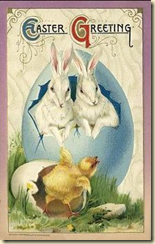The Ancient Meaning behind Modern Easter Symbols
April 24, 2011While Easter is an important time due to its’ religious associations, many of the secular symbols that are used to represent the holiday have ancient meanings that predate the religious observances that take place during this time.
The name Easter comes from the goddess Eostre, whose name was used to mark a month in the Anglo-Saxon calendar that was roughly equivalent to April. The name was used to identify this time of the year well before 899 CE and was mentioned by Bede, an English monk who lived from 672 CE to 735 CE. Eostre was a fertility goddess who was believed to be connected to fertility and growth. 
One common event that many people take part in during Easter is an Easter egg hunt. The Easter egg is actually a pagan symbol that is used to represent the Earth being reborn in the spring. Some of the most well-known decorated eggs are pysanky which come from the Ukraine. This traditional method of decorating eggs involves covering a raw egg in wax to create patterns and then dipping the egg in a series of dye baths. After each dye bath, the egg is once again coated in wax in order to preserve different colors and build further layers into the pattern. In the Ukrainian tradition, the yolk of the egg represents the sun and many of the symbols that are used relate to the worship of the sun god Dazhboh. It is believed by some Ukrainians that the world will end if people stop decorating pysanky.
In Medieval Europe, one was not allowed to consume eggs during Lent which was a time for sacrifice, prayer and self-denial. Because eggs were still being produced by chickens during this time, it was necessary to preserve them so that they would not go to waste. Because of this, eggs were often boiled in order to keep them from going bad. They were then served as part of Easter dinner and were given as gifts as well. Eggs are included in many different religious ceremonies as well.
 The Easter Bunny is one of the most widely recognized secular symbols and is the one that most children look forward to the most. Now, he is known as someone who leaves behind baskets of candy, chocolate and gifts for children to enjoy. In some countries, the Easter Bunny is known as the Easter Hare or the Spring Bunny. The tradition of the Easter Bunny was brought to the United States by German settlers in the 18th century. Historically, rabbits and hares have been symbols of fertility for much longer than that. This is due to the large litters that both animals give birth to.
The Easter Bunny is one of the most widely recognized secular symbols and is the one that most children look forward to the most. Now, he is known as someone who leaves behind baskets of candy, chocolate and gifts for children to enjoy. In some countries, the Easter Bunny is known as the Easter Hare or the Spring Bunny. The tradition of the Easter Bunny was brought to the United States by German settlers in the 18th century. Historically, rabbits and hares have been symbols of fertility for much longer than that. This is due to the large litters that both animals give birth to.
In many cases, religious legends and ancient traditions have been combined. The Easter egg is one example of this. According to some legends, Mary approached the soldiers who were at the cross when Jesus was crucified. She gave them eggs and wept as she begged them to be less cruel. When her tears struck the eggs, they became decorated with spots of color.
sc: http://ancientstandard.com/2011/04/18/painted-eggs-and-chocolate-rabbits-the-ancient-meaning-behind-modern-easter-symbols/
so Rabbit represents fertility, and egg represents birth / the beginning of life. This two things (fertility and beginning of life) shows the resurrection of Jesus Christ after the crucifixion.
CMIIW :D





0 comments